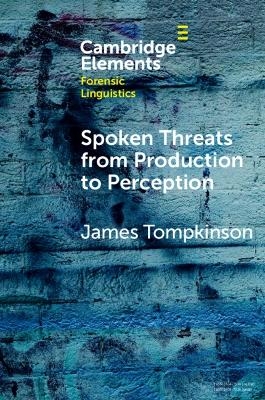
Spoken Threats from Production to Perception
Seiten
2024
Cambridge University Press (Verlag)
978-1-009-29301-3 (ISBN)
Cambridge University Press (Verlag)
978-1-009-29301-3 (ISBN)
This Element is designed to address the questions of how listeners infer traits such as how threatening speakers sound and whether phonetic aspects of speakers' voices can play a role in shaping these evaluations, alongside key differences between written and spoken threats.
Spoken threats are a common but linguistically complex language crime. Although threatening language has been examined from different linguistic perspectives, there is limited research which critically addresses how people perceive spoken threats and infer traits such as threat and intent from speakers' voices. There is also minimal linguistic research addressing differences between written and spoken threats. By specifically analysing threats delivered in both written and spoken modalities, as well as integrating perceptual phonetic analysis into discussions on spoken threats, this Element offers perspectives on these two under-researched areas. It highlights the dangers of assuming that the way in which someone sounds correlates with, for example, their intention to commit harm, and explores potential problems in assuming that written and spoken threats are equivalent to one another. The goal of the Element is to advance linguistic knowledge and understanding around spoken threats, as well as promote further research in the area.
Spoken threats are a common but linguistically complex language crime. Although threatening language has been examined from different linguistic perspectives, there is limited research which critically addresses how people perceive spoken threats and infer traits such as threat and intent from speakers' voices. There is also minimal linguistic research addressing differences between written and spoken threats. By specifically analysing threats delivered in both written and spoken modalities, as well as integrating perceptual phonetic analysis into discussions on spoken threats, this Element offers perspectives on these two under-researched areas. It highlights the dangers of assuming that the way in which someone sounds correlates with, for example, their intention to commit harm, and explores potential problems in assuming that written and spoken threats are equivalent to one another. The goal of the Element is to advance linguistic knowledge and understanding around spoken threats, as well as promote further research in the area.
Series Preface; Prologue; 1. Introduction; 2. Threatening language: a research review; 3. Analysing threat production: a corpus approach; 4. Analysing threat perception: an experimental approach; 5. Concluding thoughts; References.
| Erscheinungsdatum | 09.01.2024 |
|---|---|
| Reihe/Serie | Elements in Forensic Linguistics |
| Zusatzinfo | Worked examples or Exercises |
| Verlagsort | Cambridge |
| Sprache | englisch |
| Themenwelt | Geisteswissenschaften ► Psychologie |
| Geisteswissenschaften ► Sprach- / Literaturwissenschaft ► Sprachwissenschaft | |
| ISBN-10 | 1-009-29301-X / 100929301X |
| ISBN-13 | 978-1-009-29301-3 / 9781009293013 |
| Zustand | Neuware |
| Informationen gemäß Produktsicherheitsverordnung (GPSR) | |
| Haben Sie eine Frage zum Produkt? |
Mehr entdecken
aus dem Bereich
aus dem Bereich
Das umfassende Standardwerk auf der Grundlage der aktuellen amtlichen …
Buch | Hardcover (2024)
Duden (Cornelsen Verlag)
CHF 48,95
und wie man sie vermeidet
Buch | Softcover (2022)
C.H.Beck (Verlag)
CHF 19,55


